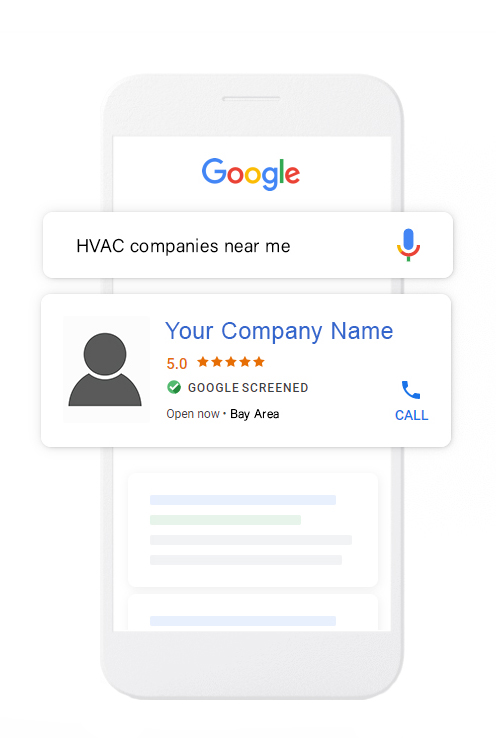 As an HVAC business owner, one of the key questions you’ll face when running Google Local Services Ads (LSAs) is, “How much should I budget for these ads?” LSAs operate on a pay-per-lead model, where you only pay when a customer contacts your business directly through the ad. However, the cost per lead can vary depending on several factors, making it essential to understand how much to allocate for your LSA campaigns. For a deeper dive into LSAs and their benefits, visit Local Service Ads for HVAC Contractors.
As an HVAC business owner, one of the key questions you’ll face when running Google Local Services Ads (LSAs) is, “How much should I budget for these ads?” LSAs operate on a pay-per-lead model, where you only pay when a customer contacts your business directly through the ad. However, the cost per lead can vary depending on several factors, making it essential to understand how much to allocate for your LSA campaigns. For a deeper dive into LSAs and their benefits, visit Local Service Ads for HVAC Contractors.
In this blog, we’ll explore the factors that influence LSA pricing, how to set an effective budget, and ways to optimize your ad spend to maximize return on investment (ROI).
Factors That Influence LSA Pricing
The cost of LSAs can vary widely based on factors such as the type of services offered, location, and competition within your service area. Understanding these variables can help you better estimate your ad spend and determine how much to budget for your campaigns.
Service Type
Different HVAC services come with different price points, and this can influence the cost of your LSAs. For example, high-ticket services such as complete HVAC installations or system replacements may have higher lead costs compared to smaller, lower-priced services like HVAC repairs or maintenance calls. Knowing which services bring in the highest revenue will help you prioritize where to allocate your ad spend.
Location
Your geographic location plays a significant role in LSA costs. In highly competitive markets—such as large cities with multiple HVAC providers—LSA costs may be higher due to increased demand for leads. However, if you’re in a smaller or less competitive area, you may find that your cost per lead is lower.
Lead Quality
The quality of leads you receive through LSAs also affects the cost. LSAs tend to generate more qualified leads, as they target customers who are actively looking for specific services in your area. High-quality leads generally justify a higher cost per lead, as they are more likely to convert into paying customers.
 How to Set an Effective LSA Budget
How to Set an Effective LSA Budget
To determine how much to spend on LSAs, you’ll need to calculate your customer lifetime value (CLV) and conversion rate to understand how much revenue each new customer brings to your business.
Step 1: Calculate Customer Lifetime Value (CLV)
The customer lifetime value (CLV) is the total revenue you can expect to earn from a customer over their relationship with your business. For HVAC businesses, this could include not only the initial service but also future maintenance, repairs, and potential referrals.
Step 2: Determine Your Conversion Rate
Your conversion rate refers to the percentage of leads that convert into paying customers. For example, if you receive 10 leads and 2 turn into customers, your conversion rate is 20%. Understanding your conversion rate helps you estimate how many leads you need to generate to meet your revenue goals.
Step 3: Set a Cost Per Lead Target
Once you know your CLV and conversion rate, you can set a cost per lead (CPL) target. For example, if a new HVAC customer typically generates $1,500 in revenue, and your conversion rate is 20%, you may want to aim for a cost per lead of $100 or less. This ensures that each lead is profitable and aligns with your business’s overall revenue goals.
Adjusting Your Budget for Market Competition
In competitive markets, you may need to allocate a higher budget for LSAs to compete effectively. Markets with a high demand for HVAC services and multiple providers bidding for leads often result in higher costs. However, there are ways to adjust your budget to remain competitive while optimizing your ad spend.
How to Compete in High-Cost Markets:
- Focus on Reputation: The Google Guaranteed badge helps set you apart from competitors. Additionally, encouraging satisfied customers to leave positive reviews can boost your LSA profile and improve your chances of converting leads.
- Target Specific Service Areas: If your overall market is highly competitive, consider narrowing your service area to target neighborhoods or suburbs where competition is lower. This can help reduce your cost per lead while still driving high-quality inquiries.
For more insights into how LSAs are priced, check out How Do Local Service Ads Work?.
Monitoring and Optimizing Your LSA Performance
It’s essential to track key performance metrics to ensure your LSA budget is being spent efficiently. Regularly monitoring the performance of your LSA campaigns allows you to adjust your strategy as needed.
Key Metrics to Track:
- Cost Per Lead (CPL): Monitoring your CPL helps ensure you’re staying within your budget. If your CPL increases, consider adjusting your service areas or bids.
- Conversion Rate: Track how many of your leads turn into paying customers. A higher conversion rate indicates that your leads are of higher quality.
- Return on Investment (ROI): Measure the revenue generated from your LSA campaigns compared to your ad spend. This will help you determine whether your budget is yielding a profitable return.
Maximize Your LSA Budget
Google Local Services Ads can be a cost-effective way to generate leads for your HVAC business, but setting the right budget is key to maximizing ROI. By understanding the factors that influence LSA pricing, calculating your customer lifetime value, and tracking key performance metrics, you can optimize your ad spend and generate high-quality leads that turn into paying customers.
Ready to take your HVAC business to the next level with LSAs? Schedule a consultation with Optimize Worldwide today, and we’ll help you set a budget that aligns with your business goals.
